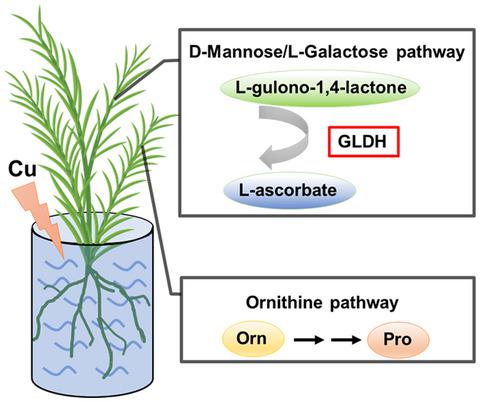当前位置:
X-MOL 学术
›
Plant Biol.
›
论文详情
Our official English website, www.x-mol.net, welcomes your
feedback! (Note: you will need to create a separate account there.)
Responses of Phragmites australis to copper stress: A combined analysis of plant morphology, physiology and proteomics
Plant Biology ( IF 4.2 ) Pub Date : 2020-08-18 , DOI: 10.1111/plb.13175 J Wu 1 , J Hu 1 , L Wang 2 , L Zhao 2 , F Ma 2
中文翻译:

芦苇对铜胁迫的响应:植物形态学,生理学和蛋白质组学的组合分析
更新日期:2020-08-18
Plant Biology ( IF 4.2 ) Pub Date : 2020-08-18 , DOI: 10.1111/plb.13175 J Wu 1 , J Hu 1 , L Wang 2 , L Zhao 2 , F Ma 2
Affiliation

|
- Few relevant research attempts have been made to determine heavy metal resistance mechanisms of rhizomatous perennial plants. Thus, it is pertinent to investigate the physiological and biochemical changes in Phragmites australis under metal‐stressed conditions to facilitate the development of strategies to enhance copper (Cu) tolerance.
- We measured parameters related to plant growth and development, metal translocation and physiological responses of P. australis subjected to Cu stress. In addition, the differentially expressed proteins (DEP) were evaluated using the isobaric tag for relative and absolute quantification (iTRAQ) system.
- A large amount of copper accumulates in the roots of P.australis, but the growth parameters were not sensitive to Cu. However, the high concentration of Cu reduced the content of chlorophyll a and chlorophyll b, and the expression of important photosynthesis proteins PsbD, PsbO and PsaA were all down‐regulated, so photosynthesis was inhibited. In contrast, the content of ascorbic acid and proline both increased with the increase of copper stress.
- P.australis fixed a large amount of Cu in its roots, limiting the migration of Cu to other parts of the plant. Moreover, Cu stress can affect photosynthesis by inhibiting the activity of PSI, PSII and LHCII. In addition, P.australis synthesizes ascorbic acid through the D‐mannose/L‐galactose pathway, and synthesizes proline through the ornithine pathway. Ascorbic acid and proline can increase Cu tolerance and protect photosynthesis. These results provide a theoretical basis for understanding the tolerance and repair mechanisms of plants in response to heavy metal pollution.
中文翻译:

芦苇对铜胁迫的响应:植物形态学,生理学和蛋白质组学的组合分析
- 很少有相关的研究尝试来确定根状多年生植物对重金属的抗性机制。因此,有必要研究在金属胁迫条件下芦苇的生理和生化变化,以促进制定提高铜(Cu)耐受性的策略。
- 我们测量了与植物生长和发育,金属易位以及受到铜胁迫的南方假单胞菌的生理反应有关的参数。此外,使用同量异位标签对相对和绝对定量(iTRAQ)系统评估差异表达的蛋白质(DEP)。
- 大量的铜的积聚在根部P.australis,但增长参数是不敏感的Cu。然而,高浓度的铜降低了叶绿素a和叶绿素b的含量,重要的光合作用蛋白PsbD,PsbO和PsaA的表达均被下调,从而抑制了光合作用。相反,抗坏血酸和脯氨酸的含量均随铜胁迫的增加而增加。
- 南美白对虾在根部固定了大量的铜,限制了铜向植物其他部位的迁移。此外,铜胁迫可通过抑制PSI,PSII和LHCII的活性来影响光合作用。此外,南美白对虾通过D-甘露糖/ L-半乳糖途径合成抗坏血酸,并通过鸟氨酸途径合成脯氨酸。抗坏血酸和脯氨酸可以提高对铜的耐受性并保护光合作用。这些结果为理解植物对重金属污染的耐受性和修复机制提供了理论基础。











































 京公网安备 11010802027423号
京公网安备 11010802027423号